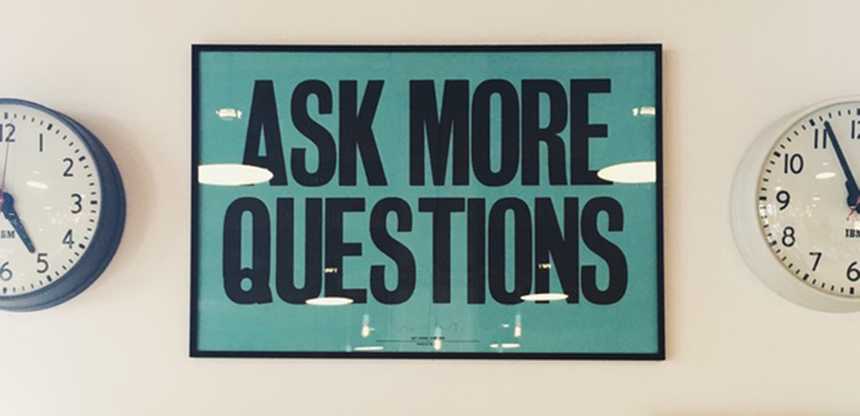Design Thinking: Points to Discuss
Published September 19, 2016

The good Design Thinking workshop motivates you to take the first steps! That’s great, but what happens afterwards? I invited my graduate Design Thinking students to contact me with their questions after leaving university and practising for a while. Here are a few typical questions and my short answers:
I am a freelance designer. My clients are used to high-end presentations, so how can I “re-educate” them to see the benefits of low-prototyping?
This is a big issue for designers. It´s not easy to change the working and communication culture in your client’s company and it´s not exactly your job as a freelance designer to be doing it. The main idea is to lock your clients out of this passive “presentation mode”.
Start with the space – invite them to your working space, or book some creative space, so everything around would scream: “There is no PowerPoint here!” Being outside their typical surroundings makes most people more open to new ideas.
Build some “co-creation” elements, so your clients become part of the working session. It´s the opposite to presentation, and creates a great dynamic and dialogue between you and your clients.
Articulate the “prototyping-issue” already during the project planning, explaining the steps you will be going through and how your clients will be involved.
How can I use Design Thinking to create social media strategy?
This is full of options! The main thing in managing social media channels is to know your users very well to provide them with relevant content and to surprise them from time to time. User research would be not just one important step in your job, but the daily business. A user-focused approach in Design Thinking would help you with monitoring your users and to come out with new innovative solutions. Maybe creating Personas is the right method for you to stay close to your target groups, or you will regularly run an empathy journey.
In the company I started to work for, we use Scrum. Could it be combined with Design Thinking?
Great idea – Scrum and Design Thinking are processes that place people’s needs first. Without knowing your company’s process, I would suggest using Design Thinking as a frame for innovation and creative problem solving, while Scrum is great in building stuff.
While trying Design Thinking, I noticed my own dissatisfaction, because everybody seems to think that they are now designers. What should I do about it?
That´s great – not you feeling dissatisfaction, but people around you feeling creative. It’s what Design Thinking is all about – co-creation within an interdisciplinary team. But it does not mean that someone can do your job instead of you. Remember the “T”-shape, that is why you are in this team as the designer – your understanding of visual language, typography, illustration, and ability to create visual experience. I bet nobody can do it instead of you.
“Personas” are still tricky for me, when should I use them and when not?
Personas are tricky not only for you but for everybody. I personally count on only well researched, data-based personas, instead of “imaginary friends” as Dan Saffer sarcastically calls ad hoc creations. Remember that the main role of your Persona is to guide you towards the right decisions. As for myself, I would prefer to find different criteria I could rely on, than to deal with implausible Personas, which can guide you and your team in the wrong direction.
Our clients want to have a project timeline, so how does project management fit with the iterative Design Thinking Process?
Trying to squeeze Design Thinking into the classical production process (like the waterfall model) will give you a headache. But agile standards are very well complimented by the Design Thinking process. Any agile framework can be planned ahead. Therefore, you could set a timeline with the main steps of the agile circle (very broad: inception, construction, transition) and list your goals for each step. These broad steps assume an iterative way of working already. Therefore, you can add methods from Design Thinking towards your agile process.
In my agency, the working frame is rather traditional (we have a classical hierarchy and communication structures), but are there still areas, like Design Research and Usability where we have more freedom? Is Design Thinking something I could apply in these gaps?
Why not? It may take you ages to wait for the right moment – having a great team, the right space, flexible furniture and do not forget those cookies we had in the class! So just start somewhere with methods you can apply and show that it works. Remember that the main point of Design Thinking is the mindset within your team.
Conclusion
A lecture at university is a dry run, it does not matter how. I have found it very exciting to learn about my students’ experiences with Design Thinking in the real work situation. During the last decade, Design Thinking was pronounced as “dead” and “expired” a few times. But now it is more alive than ever: in business, education and culture. I believe that this strength comes from Design Thinking’s ability to complement different work frames and to create relationships among people: creators, customers and users.
Thanks to everybody for your e-mails. I am excited to continue the conversation.
P.S. There are local meet-ups and groups in all social media run by a viral, willing to share community. If you want to continue learning about Design Thinking in practice – get involved!